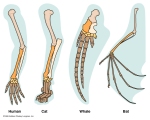 “The pectoral fins or flippers of the dolphin contain bones that appear similar [homologous] to those of the human arm and hand (as well as the forelimbs of other mammals). The pectoral fin of the dolphin, for example, contains a short bone similar to the humerus (upper arm bone) of land dwelling mammals which is attached by a ball socket type joint to a scapula (shoulder blade).” Also, the fin contains small bones which appear similar to wrist and finger bones in human hands and limbs of other animals. You usually see human hands, fins, and bat wings pictured together in textbooks, National Geographic, etc. Those who believe all animals evolved from lower life forms say this suggests a common ancestor. “But there are significant differences in both structure and function between the fin bones of dolphins and the limb bones of terrestrial mammals. Dolphins do not actually swim with their pectoral fins…but mostly use them to steer.” Also consider that, “Dolphins do not have a movable elbow joint and hold their pectoral fins rather rigidly out from the body. Their only mobile joint is at the shoulder…[which] is unsuitable for walking or grasping. The homology argument does not support evolution, but rather a common designer. For example, the rudimentary male mammary gland and nipple are clearly homologous to those of the female, but they are not taken as evidence that males once nursed their young.” Common design is the product of an intelligent designer. If a design system (such as hand/fin structure) works well, then it would be logical for the Designer to use it again. The Bible tells us the identity of that Designer—God.
“The pectoral fins or flippers of the dolphin contain bones that appear similar [homologous] to those of the human arm and hand (as well as the forelimbs of other mammals). The pectoral fin of the dolphin, for example, contains a short bone similar to the humerus (upper arm bone) of land dwelling mammals which is attached by a ball socket type joint to a scapula (shoulder blade).” Also, the fin contains small bones which appear similar to wrist and finger bones in human hands and limbs of other animals. You usually see human hands, fins, and bat wings pictured together in textbooks, National Geographic, etc. Those who believe all animals evolved from lower life forms say this suggests a common ancestor. “But there are significant differences in both structure and function between the fin bones of dolphins and the limb bones of terrestrial mammals. Dolphins do not actually swim with their pectoral fins…but mostly use them to steer.” Also consider that, “Dolphins do not have a movable elbow joint and hold their pectoral fins rather rigidly out from the body. Their only mobile joint is at the shoulder…[which] is unsuitable for walking or grasping. The homology argument does not support evolution, but rather a common designer. For example, the rudimentary male mammary gland and nipple are clearly homologous to those of the female, but they are not taken as evidence that males once nursed their young.” Common design is the product of an intelligent designer. If a design system (such as hand/fin structure) works well, then it would be logical for the Designer to use it again. The Bible tells us the identity of that Designer—God.
“Dolphin found with ‘remains of legs’”AIG Ken Ham and David Menton Nov. 5, 2006
http://www.answersingenesis.org/docs2006/1105dolphin-legs.asp
What intelligent designer would design a grasping implement like a hand and arm, then try to adapt that same design as a flipper to steer through the water, a leg to run about the land, or as a wing to fly through the air?
Does an intelligently designed plane’s wing in any way resemble its undercarriage?
By: Donald on December 20, 2011
at 8:08 am
Donald,
Honestly, I don’t think the homology argument is all that strong in favor of either evolution OR design. The examples in the highlighted picture really aren’t that similar at all in my mind. People often see what they want to see. But it is an undeniable fact that dolphin fins are marvellously suited to swimming, wings are built for flying, and hands are perfect for grasping. Awfully “lucky” don’t you think?
By: Rob Lester on December 20, 2011
at 9:50 am
There is nothing lucky about it… they are the product of millions of years of evolution. The failures die off, the successful replicate.
By: Adam on April 12, 2012
at 7:08 am
Adam,
Thank you for taking the time to comment. The fossil record should then be bursting with trillions of these “failures” but what we see is precious few remnants of these alleged millions of years. And, the fossils we DO find are fully formed and functional. There has been no true transitional form found, only a scant handful of hotly disputed candidates. If evolution is true then we should find far more examples of the failures.
By: Rob Lester on April 12, 2012
at 7:58 am
Excellent site. Plenty of helpful info here. I’m sending it to some friends ans also sharing in delicious. And obviously, thanks on your effort!
By: RussianZone это социальная сеть, которая позволяет зарегистрированным пользователям создавать собственные страницы с разнообразной информаци on July 25, 2012
at 1:02 am